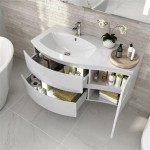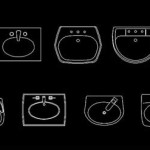How to Clean the Drain in a Bathroom Sink
A clogged bathroom sink drain can be a frustrating and inconvenient problem. Slow draining water, gurgling sounds, and even foul odors can all be signs of a blocked drain. Fortunately, cleaning a bathroom sink drain is a relatively simple task that can be done with a few basic tools and supplies. Here's a step-by-step guide to help you get rid of that pesky clog and restore your sink to its former glory.
1. Gather Your Supplies
Before you begin, make sure you have the following supplies on hand:
- Rubber gloves
- A drain snake or plumbing auger
- A plunger
- Baking soda
- Vinegar
A bucket
Optional: A wrench or pliers, a small flashlight, and a drain cleaner (chemical or enzymatic).
2. Remove the Drain Stopper
The first step is to remove the drain stopper. This will give you better access to the drain and allow you to see what's causing the blockage. Some drain stoppers are simple push-up stoppers, while others may have a more complex mechanism that needs to be unscrewed or lifted out.
3. Try a Plunger
If the clog is relatively minor, a plunger may be all you need to clear it. Fill the sink with a few inches of water, then place the plunger firmly over the drain opening. Make sure there's a good seal around the edges of the plunger. Push and pull the plunger up and down vigorously for several minutes, creating suction to dislodge the blockage.
4. Utilize a Drain Snake
If the plunger doesn't do the trick, it's time to use a drain snake or plumbing auger. This tool has a flexible cable with a hook or spiral at the end. Insert the cable into the drain and slowly rotate it while pushing it further down. The hook or spiral will catch and pull out any debris that's causing the clog. If the snake encounters resistance, gently rotate and push it through the obstruction. Be careful not to push the cable down too forcefully, as this could damage the drainpipes.
5. Employ Baking Soda and Vinegar
A baking soda and vinegar mixture is a natural and effective way to clear minor clogs. Pour a cup of baking soda down the drain, followed by a cup of vinegar. The reaction between these two substances will create a fizzing solution that can help loosen and break down the blockage. Let this sit for 30 minutes, then flush the drain with hot water.
6. Consider Chemical Drain Cleaners
If other methods fail, you can resort to using a chemical drain cleaner. However, these cleaners are highly corrosive and can damage your pipes if used improperly. Wear protective gloves and ensure proper ventilation when using chemical drain cleaners. Follow the manufacturer's instructions carefully and only use them as a last resort.
7. Prevent Future Clogs
To avoid future clogs, it's essential to prevent debris from accumulating in your bathroom sink drain. Here are a few tips:
- Use a drain strainer to catch hair, soap scum, and other debris before it goes down the drain.
- Clean the strainer regularly to prevent buildup.
- Flush the drain with hot water after each use to help prevent grease and soap residue from accumulating.
- Avoid pouring grease, oil, and other viscous substances down the drain.
- Consider using a drain-clearing product regularly for preventative maintenance.
By following these steps, you can effectively clean a clogged bathroom sink drain and prevent future clogs. Remember to exercise caution and follow the safety instructions provided for any cleaning agents you use.

How To Unclog A Sink The Right Way

3 Ways To Clean A Bathroom Sink Drain Wikihow

Best Ways To Clean Your Bathroom Sink Drain Yourself

Simple Bathroom Sink Drain Cleaner The Family Handyman

3 Ways To Clean A Bathroom Sink Drain Wikihow

How Often Should I Clean My Drains At Home

How To Clear A Clogged Drain Reviews By Wirecutter

How To Clean A Stinky Sink Drain By Home Repair Tutor

5 Things To Try If You Have A Noisy Shower Or Bathroom Sink Drain

How To Make Eco Friendly Sink And Drain Cleaner Bond Cleaning In Brisbane







